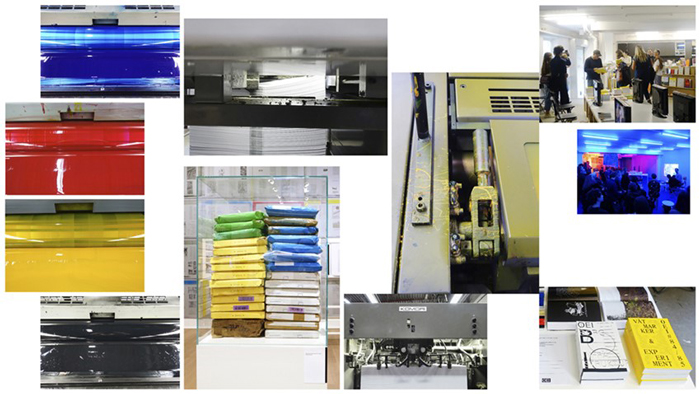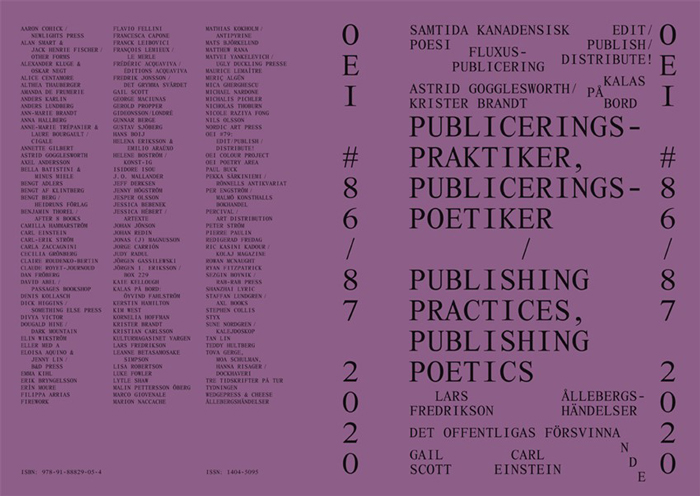
COLLAGE NEWS
OEI #86-87: Publishing Practices, Publishing Poetics
Kolaj Magazine editor Ric Kasini Kadour’s essay “But Print Is Dead: The Story of Kolaj Magazine” is included in OEI #86-87: Publishing Practices, Publishing Poetics. Kadour explains the role publishing plays in his culture work. The essay is a critique of the current rhetoric that casts print publishing as a dying practice and proposes that what dying print publications are missing is a value around community service and building. The article includes collages from German collage artists Kornelia Hoffmann and Denis Kollasch.
“In 2011, when I began to tell people that I was starting a print magazine about collage, their reaction was almost universal: ‘But print is dead.’ They weren’t wrong, but they weren’t right,” writes Kadour. “Culture may be irrational and idiosyncratic, but thankfully so are other human beings. The very thing that was supposedly killing print also made it possible for like-minded individuals to find one another.”
OEI is a Stockholm, Sweden-based cultural magazine and literary project run by Jonas (J) Magnusson and Cecilia Grönberg. OEI exists “for extra-disciplinary spaces and de-disciplinizing moments–experimental forms of thinking, montages between poetry, art, philosophy, film, and documents; critical investigations, editorial enunciations, aesthetic technologies, non-affirmative writing, speculative archaeologies, new ecologies and counter-historiographies. OEI magazine was founded in 1999.

The publishers write:
Bringing together contributions from circa 130 publishing structures, publishing communities, magazines, small press endeavors, artists, poets, writers, editors, theoreticians, curators, scholars, and art bookstores, OEI # 86–87 reflects upon the challenges, pressures and possibilities of publishing and creating publics in different contexts and places in a time of far-reaching – economical, medial, political, social, technological – transformations.
The potential and the versatility of publishing open it to a diversity of practices and approaches in the arts, but as an eminently social form of art, a collective or micro-collective work with shared responsibilities, it is also a never-ending process of “crafting a variegated approach to how you create, publish, distribute, and build a social ecosystem around your efforts”, of trying to “build up and strengthen the community around these printed forms” (Temporary Services).
It is the conviction of OEI #86–87 that print has the power to play an important part in the construction of social spaces, of a social world. As Benjamin Thorel puts it in one of the essays in the issue, “conceiving of the dynamics of publishing as making publics as well as making things public is not a pun – insofar as the artists/publishers encompass, beyond the book itself, its possible ‘lives’, imagining the different spaces, and the different people, amongst whom a publication will circulate.” This is what Michael Warner has called “a public [as] poetic worldmaking”, implying “that all discourse or performance addressed to a public must characterize the world in which it attempts to circulate, projecting for that world a concrete and livable shape, and attempting to realize that world through address.”
This is also, as stressed by Annette Gilbert and others, what can make publishing such an active force, a force co-constituting texts and publications and publics. Indeed, with Michalis Pichler, it is tempting to say that in publishing as practice – perhaps more than in any other art field – “artists have been able to assert the aesthetic value of their own socio-politically informed concerns and to engage, often under precarious conditions, in cultural activities fully aligned with their political values.”
OEI #86–87 also includes sections on and with contemporary poetry from Canada; Fluxus publishing; Krister Brandt/Astrid Gogglesworth; Kalas på BORD (Öyvind Fahlström); Lars Fredrikson; Claude Royet-Journoud’s poetry magazines; Carl Einstein; Gail Scott; Ållebergshändelser; OEI #79: edit/publish/distribute!; “det offentligas försvinnande”
How to purchase an issue?
In Sweden, issues of OEI magazine and books by OEI editör can be ordered from Daidalos (daidalos.se) or from a Swedish bookstore or internet bookstore. WEBSITE
EVENTS
Publication Launch: OEI #86-87: Publishing Practices, Publishing Poetics
at Index – The Swedish Contemporary Art Foundation
Kungsbro Strand 19, Stockholm
Thursday, 5 March 2020, 6:30-9:30PM
Please join OEI at Index for an evening on publishing practices & publishing poetics at the occasion of the release of the new 640-page issue of OEI, # 86–87. At Index a number of publishing projects, artists and writers – Art Distribution, Dark Mountain (Dougald Hine), Det Grymma Svärdet, Dockhaveri, OEI, Rab-Rab, STYX, and Carla Zaccagnini – will present their publishing practices and discuss their publishing poetics and publishing ecologies. Language: Swedish and English. WEBSITE
OEI at Melbourne Art Book Fair
at the National Gallery of Victoria International
180 St. Kilda Road, Melbourne, Victoria, Australia
13-15 March 2020, 10AM-5PM
The Melbourne Art Book Fair 2020 will bring together publishers, artists and designers to showcase some of the world’s best art and design publications for discussions, book launches and workshops. WEBSITE
